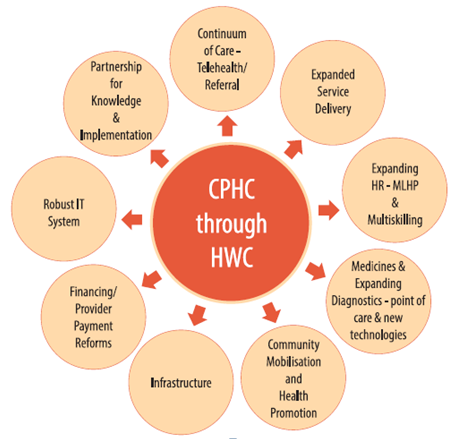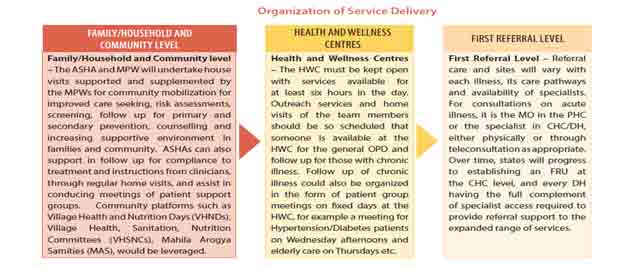The National Health Mission (NHM), the country's flagship health systems strengthening programme, particularly for primary and secondary health care envisages "attainment of universal access to equitable, affordable and quality health care which is accountable and responsive to the needs of people". Investments during the life of the NHM were made to strengthen Reproductive and Child Health (RCH) services and limit the increasing burden of communicable diseases such as Tuberculosis, HIV/AIDS and vector borne diseases. While such a focus on selective primary health care interventions, enabled improvements in key indicators related to RCH and communicable diseases, the range of services delivered at the primary care level did not take into account increasing disease burden and rising costs of care on account of chronic diseases.
The National Health Policy, 2017 recommended strengthening the delivery of primary health care, through establishment of "Health and Wellness Centres" as the platform to deliver comprehensive primary health care and called for a commitment of two thirds of the health budget to primary health care.
The Report of the Primary Health Care Task Force, Ministry of Health and Family Welfare, Government of India while reiterating that primary health care is the only affordable and effective path for India to Universal Health Coverage, also provided valuable insights into structure and processes in health systems to enable Comprehensive Primary Health Care (CPHC).
Ayushman Bharat or "Healthy India" national initiative was launched as recommended by the National Health Policy 2017, to achieve the vision of Universal Health Coverage (UHC). This initiative has been designed on the lines as to meet SDG and its underlining commitment, which is "leave no one behind".
AyushmanBharat is an attempt to move from sectoral and segmented approach of health service delivery to a comprehensive need-based health care service. Ayushman Bharat aims to undertake path breaking interventions to holistically address health (covering prevention, promotion and ambulatory care), at primary, secondary and tertiary level.
Ayushman Bharat adopts a continuum of care approach, comprising of two inter-related components, which are -
In February 2018, the Government of India's announced the creation of 1,50,000 Health and Wellness Centres (HWCs) by transforming existing Sub Centres and Primary Health Centres as the base pillar of Ayushman Bharat. These centres would deliver Comprehensive Primary Health Care (CPHC) bringing healthcare closer to the homes of people covering both maternal and child health services and non-communicable diseases, including free essential drugs and diagnostic services.
Health and Wellness Centers, are envisaged to deliver and expanded range of services to address the primary health care needs of the entire population in their area, expanding access, universality and equity close to the community. The emphasis of health promotion and prevention is designed to bring focus on keeping people healthy by engaging and empowering individuals and communities to choose healthy behaviours and make changes that reduce the risk of developing chronic diseases and morbidities.
The delivery of Universal Comprehensive Primary Health Care, through HWCs will increase the health system responsiveness to people by bringing services closer to the communities and being able to address the needs of most marginalized, through Primary Health Care team.
The other component of Ayushman Bharat, namely Pradhan Mantri Jan Arogya Yojana (PMJAY) aims to provide financial protection for secondary and tertiary care to about 40% of India's households. Together the two components of Ayushman Bharat will enable the realization of the aspiration of Universal Health Coverage (read more https://www.pmjay.gov.in/)
To ensure delivery of Comprehensive Primary Health Care (CPHC) services, existing Sub Centres covering a population of 3000 -5000 would be converted to Health and Wellness Centres, with the principle being "time to care" to be no more than 30 minutes. Primary Health Centres in rural and urban areas would also be converted to HWC. Such care could also be provided/ complemented through outreach services, Mobile Medical Units, camps, home and community-based care, but the principle should be a seamless continuum of care that ensures the principles of equity, universality and no financial hardship.
The HWC at the Sub Health Centre level would be equipped and staffed by an appropriately trained Primary Health Care team, comprising of Multi-Purpose Workers (male and female)&ASHAs and led by a Mid-Level Health Provider (MLHP). Together theywill deliver an expanded range of services. In some states, sub health centres have earlier been upgraded to Additional PHCs. Such Additional PHCs will also be transformed to HWCs.
A Primary Health Centre (PHC) that is linked to a cluster of HWCswould serve as the first point of referral for many disease conditions for the HWCs in its jurisdiction. In addition, it would also be strengthened as a HWC to deliver the expanded range of primary care services.
The Medical Officer at the PHC would be responsible for ensuring that CPHC services are delivered through all HWCs in her/his area and through the PHC itself. The number and qualifications of staff at the PHC would continue as defined in the Indian Public Health Standards (IPHS).
For PHCs to be strengthened to HWCs, support for training of PHC staff (Medical Officers, Staff Nurses, Pharmacist, and Lab Technicians), and provision of equipment for "Wellness Room", the necessary IT infrastructure and the resources required for upgrading laboratory and diagnostic support to complement the expanded ranges of services would be provided. States could choose to modify staffing at HWC and PHC, based on local needs.

The HWC would deliver an expanded range of services. These services would be delivered at bothSHCs and in the PHCs, which are transformed as HWCs. The level of complexity of care of services delivered at the PHC would be higher than at the sub health centre level and this would be indicated in the care pathways and standard treatment guidelines that will be issued periodically.
To ensure equitable population coverage and to address issues of marginalization, the frontline workers would create population-based household lists and undertake registration of all individuals and families residing within the catchment area of a Health and Wellness Centre. It is this registration that is referred to as empanelment. It is a right of anyone, resident in that area to be enrolled.
The delivery of services would be at three levels i.e., i) Family/Household and community levels, ii) Health and Wellness Centres and iii) and Referral Facilities/Sites.

The services envisaged at the HWC level will include early identification, basic management, counselling, ensuring treatment adherence, follow up care, ensuing continuity of care by appropriate referrals, optimal home and community follow up, and health promotion and prevention for the expanded range of services. Care provision at every level would be provided as per clinical pathways and standard treatment guidelines.

This Portal is designed, developed and hosted by Centre for Health Informatics (CHI) of the National Health Portal (NHP), by the Ministry of Health and Family Welfare (MoHFW), Government of India
Page Last updated on June 10, 2025
© 2025 MoHFW, Government of India, All rights reserved.

